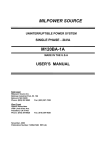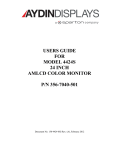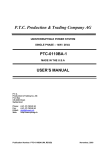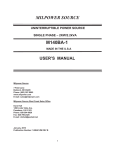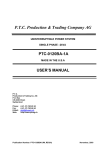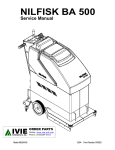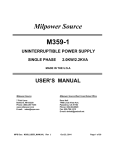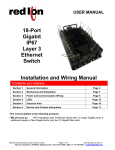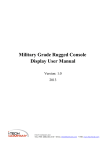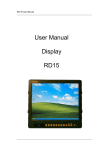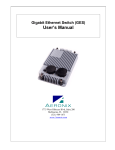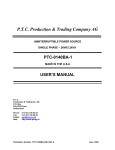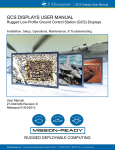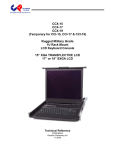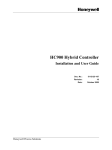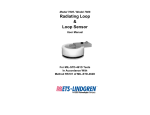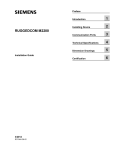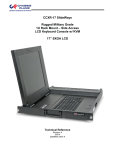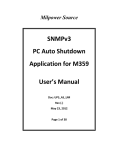Download M110BA-2 User Manual (in PDF format)
Transcript
MILPOWER SOURCE UNINTERRUPTIBLE POWER SOURCE 400Hz IN, 60Hz OUT SINGLE PHASE – 1kW / 2kVA M110BA-2 MADE IN THE U.S.A USER’S MANUAL East Coast Milpower Source 7 Field Lane, RTE. 106 Belmont, NH 03220 Phone: (603) 267-8865 Fax: (603) 267-7258 West Coast Hytech Associates 1498 Linda Vista Ave. Pasadena, CA 91103 Phone: (818) 7964761 Fax: (818) 304-9620 November, 2003 Publication Number: 110BA2UM, REV(A) MILPOWER SOURCE 110BA2UM, REV(A) 110BA2UM, REV(A) Table of Contents 1. 1.1 1.2 2. 3. 4. 4.1 4.2 5. 6. 6.1 6.2 6.2.1 6.2.2 6.2.3 6.2.4 6.2.5 6.3 7. 7.1 7.2 8. 8.1 8.1.1 8.1.2 8.2 8.3 9. Page Safety Instructions .................................................................................................iii General Description.................................................................................................1 Intended Applications .............................................................................................1 Functional Overview ...............................................................................................1 (Deleted) ...................................................................................................................3 Installation Instructions ..........................................................................................3 Front Panel Description ..........................................................................................4 Front Panel: Main Components ............................................................................4 Front Panel: Indicators and Switches ..................................................................5 Rear Panel Description ...........................................................................................6 Operation, Controls and Indicators .......................................................................7 Turning the UPS ON and OFF ................................................................................7 Visual Indicators ......................................................................................................7 Normal Operation ....................................................................................................7 Standby Mode ..........................................................................................................7 Input AC Failure .......................................................................................................8 Overload Condition .................................................................................................8 Over Temperature Condition..................................................................................8 Battery Test ..............................................................................................................9 Taking Care of the Battery......................................................................................9 Battery Service Life .................................................................................................9 Replacing the Battery Pack ..................................................................................10 Communications and Remote Control................................................................11 Dry Contacts Interface ..........................................................................................11 Option 0 (Standard) Dry Contacts Interface .......................................................11 Option 1 Dry Contacts Interface...........................................................................12 RS-232 Communication Interface ........................................................................13 Remote ON/OFF Interface…………………………………………………………….15 Specifications ........................................................................................................14 List of Figures Fig. 1 Fig. 2 Fig. 3 Fig. 4 Fig. 5 Fig. 6 Fig. 7 Page Block Diagram..........................................................................................................2 Electrical Connections ............................................................................................3 Front Panel - Main Components ............................................................................4 Front Panel - Indicators ..........................................................................................6 Rear Panel ................................................................................................................6 Dry Contacts - Option 0.........................................................................................12 Dry Contacts - Option 1.........................................................................................12 List of Tables Page Table 1 Dry Contacts Connector J3 Pin Assignment (Option 0)....................................11 Table 2 Dry Contacts Connector J3 Pin Assignment (Option 1)....................................12 Table 3 RS232 Connector J4 Pin Assignment .................................................................13 ii MILPOWER SOURCE 110BA2UM, REV(A) IMPORTANT SAFETY INSTRUCTIONS • The M110BA-2 contains an internal high voltage, high energy power source (96VDC battery) and large high voltage (340VDC) capacitors. • The unit should not be tampered with by unauthorized personnel !!! • Turning off the Input ON/OFF Switch and/or disconnecting the input connector do not turn off the UPS !!! • The unit should only be plugged into an approved double-pole and fused 20A electrical outlet !!! • The Replaceable Battery Pack of the M110BA-2 (MPS P/N M357380) contains lead-acid batteries. The Battery Pack should not be opened. It can only be replaced with a new pack (battery cells cannot be replaced individually). • Dispose the Battery Pack properly. Careless disposal (such as into a fire) may cause an explosion. Local regulations may require controlled disposal of lead-acid batteries. Please check your local regulations before disposal. iii MILPOWER SOURCE 1. General Description 1.1 Intended Applications 110BA2UM, REV(A) The M110BA-2 is a high quality, rugged, 400Hz IN 60Hz OUT, 1kW / 2KVA, 19” rack-mounted Uninterruptible Power Source (UPS). In addition to full compliance with all the requirements of MILSTD-1399 (Section 300), the M110BA-2 is specifically designed to meet the harsh military shipboard environment. The high reliability and ruggedness of the M110BA-2 make it an excellent choice not only for military shipboard applications, but for tactical shore-based applications as well. 1.2 Functional Overview The M110BA-2 consists of two main sections: Power Conditioner and UPS (see Fig. 1). The Power Conditioner is a 400Hz isolation transformer (with RFI filters and spike absorbers). In addition to 115Vac to the UPS section, the isolation transformer provides a low voltage for the 24Vdc contactor supply. When AC input drops, the 24Vdc is provided from battery power. The Power Conditioner contains internal fuses on its input. These internal fuses are intended only as a safety feature in case of an internal failure. The UPS is composed of a high power factor AC-DC Converter, a Removable Battery Pack, a Battery Charger, a DC-AC Inverter and a microcontroller-based Control Circuit. The AC-DC Converter is a high frequency switching converter that provides 320VDC to the DC-AC inverter. The AC-DC converter draws clean sine input current waveform and does not induce electrical noise into the input lines. The Removable Battery Pack contains the energy source used by the UPS to provide power during AC input failures. The Battery Pack includes eight 12V / 5AH lead-acid, sealed, maintenance-free type cells. It provides 10 minutes of full rated output power. The Battery Pack is not a serviceable item. It cannot be disassembled, and can only be replaced as a single unit. The Battery Charger is a high frequency, voltage-regulated and current-limited DC to DC converter. It is powered from the 320VDC output of the AC-DC Input Converter and provides temperaturecompensated float charge to the Battery Pack. The DC-AC Inverter is a high frequency inverter that generates a clean sine-shape 60Hz, 115VAC voltage from the 320VDC output of the AC to DC Input Section. The DC-AC Inverter is currentlimited and has an overload protection circuit that turns it off (latched) after a delay from the time the load exceeds 120%. The delay depends upon the overload level. The Control Circuit is a microcontroller-based circuit that provides monitoring of the unit’s status (battery charge, load level, input and output levels, etc.) and supports communications and front panel status indicators. 1 MILPOWER SOURCE RFI FILTER & VARISTOR J1 AC INPUT 115VAC,400Hz 110BA2UM, REV(A) ISOLATION TRANSFORMER RFI FILTER & VARISTOR Power Conditioner Low Voltage To Contactors 2 POLES INPUT CONTACTOR AC-DC CONVERTER 320 Vdc 2 POLES OUTPUT CONTACTOR DC-AC INVERTER J2 AC OUTPUT 115VAC,60Hz J5 REMOTE ON/OFF SWITCH 120 VDC BATTERY CHARGER J5 INPUT ON/OFF SWITCH 24 VDC MASTER ON/OFF SWITCH BATTERY PACK CONTROL & MONITOR 24VRTN 24VDC Figure 1: M110BA-2 Block Diagram 2 J4 RS-232 J3 DRY CONTACTS MILPOWER SOURCE 110BA2UM, REV(A) 2. (Deleted) 3. Installation Instructions Before installing the unit, please read carefully the Safety Instructions at the beginning of this manual. Make sure that the Master switch is in the OFF position. Two circular connectors (J1 and J2) are provided on the rear panel of the UPS (see Figure 5). J1 is the input connector, J2 is the output of the UPS. Figure 2 below, shows the electrical power connections of the M110BA-2. After the unit is installed and ready to be turned ON, see paragraph 6.1 (Turning the UPS ON and OFF) for operating instructions. 115VAC/400Hz INPUT VIA 20AMP CIRCUIT BREAKER Chassis GND A Input Phase 1 B Input Phase 2 C Chassis GND 115VAC 60Hz to LOAD J1 UPS A J2 AC Out (Neutral) B AC Out (Hot) C Safety GND J1 J2 MS3102A-22-2P or comp. MS3102A-22-2S or comp. Rear panel GND connection Figure 2 – Electrical Connections 3 MILPOWER SOURCE 110BA2UM, REV(A) 4. Front Panel Description 4.1 Front Panel: Main Components (See Figure 3) 1. Removable air filter (of the Power Conditioner’s cooling air). 2. Visual Indicators and Switches (for detailed view see Figure 4). 3. Air Inlet (of main UPS heatsink). 4. Input ON/OFF Switch. 5. Master ON/OFF Switch. M110BA-2 1KW,400HZ IN 60HZ OUT UPS. 1 4 2 5 3 Figure 3 - Front Panel: Main Components 4 MILPOWER SOURCE 4.2 110BA2UM, REV(A) Front Panel: Indicators and Switches (See Figure 4) 4. 5. 6. 7. 8. 9. 10. 11. 12. 13. 14. 15. 16. 17. 18. 19. 20. 21. 22. Input ON/OFF switch. Master ON/OFF switch. Input Fail LED (red). Input OK LED (green). Output Standby LED (yellow). Output OK LED (green). Output Fail LED (red). On Battery Warning LED (blinking yellow). Alarm Off Push-button. Low Battery Warning LED (blinking yellow). Overload Shutdown LED (red). Overtemperature Warning LED (blinking yellow). Overtemperature Shutdown LED (red). Load Level Bar Graph (marked in %, 100% = 1000W ). Battery Charge Bar Graph (marked in %., 100% = 10 minutes at 1000W load). Set Battery Charge to 100% Push-button (for maintenance only). Battery Test Passed LED (green). Battery Test Push-button. Battery Test Failed LED (red). Figure 4 - Front Panel: Indicators and Switches 5 MILPOWER SOURCE 5. 110BA2UM, REV(A) Rear Panel Description (See Figure 5) 23. Cooling Fan (Air Outlet). 24. J1 Input Power Connector (see Figure 2 for pin out). 25. J2 Output Power Connector (see Figure 2 for pin out). 26. GND Connection. 27. Dry Contacts Connector J3 (see paragraph 8 for pin out description). 28. RS232 Connector J4 (see paragraph 8 for pin out description). 29. Optional Bushing (2 places). 30. Remote ON/OFF connector J5. Figure 5 - Rear Panel 6 MILPOWER SOURCE 110BA2UM, REV(A) 6. Operation, Controls and Indicators (ref. Figures 3 and 4) 6.1 Turning the UPS ON and OFF In order to turn the UPS ON (after the electrical connections are made), turn ON the Input ON/OFF switch (4), the Master ON/OFF switch (5) and if used, the remote ON/OFF switch. (The order is not important). If remote ON/OFF is not used, the connections of J5 (described in paragraph 8.3) should be installed before the unit is turned on. When the Master ON/OFF switch (5) or the remote ON/OFF switch are turned off, the internal contactors open and disconnect both the input and the output of the UPS and it turns OFF. When the UPS operates, turning off the Input ON/OFF switch (4) disconnects the UPS from the AC input, and the UPS then runs on battery power only. To turn the UPS off, the Master ON/OFF switch or the remote ON/OFF switch must be in the OFF position. (It will automatically disconnect the input connector too). Note: The UPS will not start on battery power (to avoid battery discharge during shipping and storage). Hence, the Input ON/OFF switch must be ON and AC voltage must be present at the input in order to start the UPS. When a remote control of the UPS is desired, the Input ON/OFF and the Master ON/OFF switches on the front panel should be both in the ON position. Turning the remote ON/OFF switch ON and OFF will turn the UPS ON and OFF. (Please see paragraph 8.3). 6.2 Visual Indicators 6.2.1 Normal Operation When the UPS is running on AC input power and both Master and Input switches are ON, the two bar graphs (17, 18), the green Input OK LED (7) and the green Output OK LED (9) are on. The Load Level Bar Graph (17) indicates the loading percentage of the UPS. 100% load is equal to 1000W of output power. The lower six positions of the Load Level Bar Graph (15% to 75%) are green. The next three positions (80%, 110%, 120%) are orange and the two uppermost positions (130% and 140%) are red. The colors do not have any special significance and are only intended to assist fast scanning of the load level. The Battery Charge Bar Graph (18) indicates the percentage charge level of the battery. 100% signifies that at least 10 minutes of full load will be supported by the battery, 50% signifies 5 minutes at full load and so on. Lower loads result in longer expected battery operation time. When the battery is being charged, the uppermost active segment of the Battery Charge Bar Graph blinks to indicate that charging is on. 6.2.2 Standby Mode When the yellow Output Standby LED (8) is on, the UPS is in the Standby Mode. In this Mode the DC-AC inverter is OFF and the output contactor is open, but all other function of the UPS are active (including battery charging and RS-232 communication port). The UPS reaches this mode when command by the RS-232 or the “dry relays” into this mode. 7 MILPOWER SOURCE 6.2.3 110BA2UM, REV(A) Input AC Failure When the input AC voltage is below the minimum required for proper operation, the UPS runs on battery power. During this condition the red Input Fail LED (6) is on, the yellow On Battery Warning LED (11) blinks, and five seconds after input power loss an audible alarm starts beeping once every five seconds. To turn off the audible alarm, press momentarily on the Alarm OFF Push-button (12). When the button is pressed, a short beep will sound to indicate compliance. During battery operations, the Battery Charge Bar Graph (18) continuously displays the battery charge level. When the charge in the battery drops below 35%, the yellow Low Battery Warning LED (13) starts blinking (indicating that less than 3.5 minutes of full load may be supported by the battery) and the audible alarm emits two short beeps once every five seconds.. To turn off the audible alarm, press momentarily on the Alarm OFF Push-button (12). When the button is pressed, a short beep will sound to indicate compliance. When the Battery Charge Bar Graph reaches 0% (no segments are lit), the UPS will continue to operate until the actual voltage of the battery trips the battery protection circuit and shuts down the UPS. When the input AC voltage recovers, the UPS will turn on automatically. 6.2.4 Overload Condition If the load exceeds the rating of the UPS or there is a short circuit on the UPS’s output, the protection circuit of the UPS will shut down the UPS output (after a short delay, depending on the depth of the overload). This condition is indicated by the red Output Fail LED (10) and the red Overload Shutdown LED (14). To recover from overload shutdown: Turn off the Master ON/OFF switch (5). Remove the overload (or short circuit) from the UPS output. Turn on the Master ON/OFF switch (5). The output may turn on immediately or after a short delay, depending on the duration the unit was off. During this delay the yellow Output Standby LED (8) blinks. 6.2.5 Over Temperature Condition When the internal temperature of the UPS exceeds a preset level, the yellow Over Temperature Warning LED (15) blinks and audible alarm sounds at one second intervals, 50% duty cycle. Three minutes after the Over Temperature Warning LED starts to blink (and if the temperature does not drop), the UPS shuts itself off. This condition is indicated by the red Over Temperature Shutdown LED (16) and the red Output Fail Led (10). Recovery from Over Temperature Shutdown is automatic when the temperature drops. Check condition of the Air Filter on the front panel. If it is dirty - clean it and re-install into the unit. 8 MILPOWER SOURCE 6.3 110BA2UM, REV(A) Battery Test Battery Test may be invoked only if the UPS runs on AC input power, the Battery Charge level is above 85%, the load is above 35% and the battery is not engaged in supporting Input Power Limit. If Battery Test is denied due to low charge level, the Charge Level Bar Graph blinks once when the Battery Test Push-button is pressed. To test the battery, press momentarily on the Battery Test Push-button (21). The green Battery Test Passed LED (20) will blink for about 3 seconds (indicating that Battery Test is running). After about 3 seconds, either the red Battery Test Failed LED (22) will turn on (and latch), indicating a bad battery, or the green Battery Test Passed LED (20) will turn on for about 20 seconds, indicating that battery successfully passed the test. The Battery Test may be repeated only after at least 20 seconds have elapsed since the last test. 7. Taking Care of the Battery 7.1 Battery Service Life The gel lead-acid, sealed and maintenance-free battery used in the M110BA-2 is of the highest quality. Nevertheless, it is a Limited Life Item, and its life expectancy depends upon its operating and storage conditions. The three most important factors that determine the life of the battery are: Temperature Storage Conditions Charge-Discharge Cycles Temperature The battery used in the M110BA-2 is sealed and does not “dry up” or lose gasses, but its end of service life is brought about by the gradual corrosion of the electrodes. This process is accelerated by high operating temperatures. Every 10°C rise above 20°C will reduce the battery service life by half. Storage Conditions When lead-acid batteries are stored for extended periods of time, lead sulfate is formed on the negative plates and insulates them. The sulfating rate depends on the ambient temperature and the charge level of the battery. High temperature and low charge level accelerate the sulfating and reduce the battery life. In order to protect your battery from damage during storage: • Make sure the battery is fully charged periodically (every 4 months if the temperature is approximately 24°C, and every two months if the temperature is higher than 37°C) by operating the UPS for at least four hours. • Store the batteries in a cool place (may be stored separately from the UPS). • Never store a discharged battery !!! 9 MILPOWER SOURCE 110BA2UM, REV(A) Charge-discharge Cycles The number of times and the depth of battery discharges (during AC input failure) affects the service life of the battery. If the battery is allowed to discharge only to 50% of its charge, the number of charge-discharge cycles (before it fails) will be three times the number of cycles had it been allowed to reach 30% charge. Battery life may be prolonged by limiting the operating time on battery power to the minimum required by the system to perform an orderly shutdown. 7.2 Replacing the Battery Pack For ease of use, the battery of the M110BA-2 is packaged within a Removable Battery Pack (MPS P/N M357380) that may be ordered separately. During storage, the Battery Pack may be removed and stored separately in a cooled ambient. To remove the Battery Pack from the UPS: a) Turn OFF the Master ON/OFF switches. b) Disconnect J1 and J2 from the rear panel. c) Open seven screws on the battery’s rear cover. d) Open the Battery Connector access cover. Remove screws. e) Disconnect the connector by pulling upward. f) Unscrew the right battery’s screws on the top and three screws on the right side of the UPS (marked by a B” on the top and recessed on the side). g) Hold the Battery Pack by the two edges on the sides (Caution: Two-man lift !!) and lift it straight up. To install a new battery: a) Lower the Battery Pack straight into its place (at the right side of the UPS). Verify that the battery mating connector and harness (near the front panel) are not damaged by the battery. b) Install the screws on the top and the right side without tightening them yet. After all screws are in, torque them at 11 IN.LB for the #6 top screws and 22 IN.LB for the #8 side screws. Note: Suitable locking compound (Locktite 242, or similar) should be applied to all screws. c) Connect the battery connector. d) Close the battery connector cover and tighten its screws (6.5 IN.LB). e) Close the battery’s rear cover and tighten its screws (6.5 IN.LB). f) Reconnect J1 and J2 to the rear panel. The unit is now ready for operation. Note: If the new battery is fully charged, press the Set-Battery-Charge-to-100% Push-Button for ten seconds to set the charge level to full scale. 10 MILPOWER SOURCE 110BA2UM, REV(A) 8. Communications and Remote Control 8.1 Dry Contacts Interface Dry Contacts Interface is available through connector J3 ( a DB9 male connector located on the rear panel). This interface allows control and monitoring of the UPS by a server. Two configurations are available: Option 0 (Standard) and Option 1. 8.1.1 Option 0 (Standard) Dry Contacts Interface Table 1 shows J3 pin assignment for Standard configuration, Option 0. Table 1 Dry Contacts Connector J3 Pin Assignment, Standard configuration, Option 0 PIN 1 2 3 4 5 6 7 8 9 I/O O O I O O O O DESCRIPTION Fault Detect Signal Low Fault Detect Signal High Remote Shutdown Not Battery Operation System Common Ground N.C. Battery Voltage Low UPS On Input Power Loss, Battery operation NOTES (1) (1) (2) (3) (4) (5) (3) Notes to Table 1: 1. Pin 1 is shorted to pin 2 when any one of the following conditions occurs: Over Temperature Condition Battery failure Charger Failure Internal UPS Controller Failure 2. Connecting 5 to 12Vdc ( + to pin 3, - to pin 5) causes the UPS to shutdown if in Battery Mode (latched). If in AC mode, the UPS enters a Standby Mode (Ac output is off, all other functions are on.) 3. If the UPS operates on battery power, pin 9 is shorted to pin 5 and pin 4 is open. Otherwise, pin 4 is shorted to pin 5 and pin 9 is open. 4. If battery voltage is low, pin 7 is shorted to pin 5. Otherwise, pin 7 is open. 5. If UPS output is OK, pin 8 is shorted to pin 5. Otherwise, pin 8 is open. Figure 6 shows the dry contacts interface circuits for Option 0. 11 MILPOWER SOURCE 8.1.2 110BA2UM, REV(A) Option 1 Dry Contacts Interface Table 2 shows J3 pin assignment for Option 1. In this option the server interfaces to the UPS via a quasi - RS232 communication link Table 2 Dry Contacts Connector J3 Pin Assignment, Option 1 PIN 1 2 3 4 5 6 7 8 9 DESCRIPTION Remote Shutdown Return Mains Fail Relay, normally closed Mains Fail Relay, normally open Low Bat Relay, normally open Low Bat Relay, normally closed Remote Shutdown Mains Fail Relay, center pole Low Bat Relay, center pole N.C. NOTES (1) (2) (2) (3) (3) (1) (2) (3) Notes to Table 2: 1. Connecting 5 to 12Vdc ( + to pin 6, - to pin 1) causes the UPS to shutdown if in Battery Mode (latched). 2. If AC input is good, pin 7 is shorted to pin 2 and pin 3 is open. If AC input is bad, pin 7 is shorted to pin 3 and pin 2 is open. 3. If battery voltage is good, Pin 8 is shorted to pin 5 and pin 4 is open. If battery voltage is bad, Pin 8 is shorted to pin 4 and pin 5 is open Fig 7 shows the dry contacts interface circuits for Option 1. J3 J3 1K 1K 3 REMOTE S.D (+) 6 REMOTE S.D. (+) 5 SYSTEM GND 1 RTN RMT S.D. 7 BAT V LOW 8 UPS ON 9 BAT OPER 4 NOT BAT OPER 1 FLT DET HI 2 FLT DET LO 7 MAINS FAIL CTR 2 MAINS FAIL N.C. 3 MAINS FAIL N.O. 8 LOW BAT CTR 5 LOW BAT N.C. 4 LOW BAT N.O. Figure 7 - Dry Contacts - Option 1 Figure 6 - Dry Contacts - Option 0 12 MILPOWER SOURCE 8.2 110BA2UM, REV(A) RS-232 Communication Interface The RS232 serial communication interface is available through connector J4 ( a DB9 female connector located on the rear panel of the UPS.) This interface allows control and monitoring of the UPS by a host computer through the serial RS232 communication link. For further information about this feature refer the M120BA-1 Software User Manual. Table 3 shows the standard RS232 pin assignment. Table 3 - RS232 Connector J4 Pin Assignment Pin 1 2 3 4 5 6 7 8 9 8.3 I/O Symbol Description Internally shorted to J3 pin 5. (not used by RS232 link) Input RXD Receive Data Output TXD Transmit Data Output DTR Data Terminal Ready --------- SG Signal Ground Input DSR Data Set Ready Output RTS Request To Send Input CTS Clear To Send Internally shorted to J3 pin 9. (not used by RS232 link) Remote ON/OFF Interface J5 Important note: The M110BA-2 is shipped with a matting connector plugged into J5, with a jumper that enables the unit. If remote ON/OFF is not desired, do not remove it. The remote ON/OFF Interface J5 provides a mean for turning the UPS ON and OFF by a remote panel switch. When pin 8 or 15 of J5 are connected to pin 7 or 14 of J5 (8 is internally connected to 15 and 7 is internally connected to 14) the UPS is enabled. It will be ON only if the Master ON/OFF is also ON. When pins 8 and 15 are not connected (externally) to pins 7 or 14 the UPS will be OFF regardless of the position of the switches on the front panel. To control the UPS by the remote switch, leave the front panel switches in the ON position and turn the UPS ON and OFF by closing (ON) and opening (OFF) the remote switch. The remote switch should be rated to 28Vac, 0.5AMP. Connector J5 Pin Symbol 8,15 Remote ON/OFF 7,14 Remote ON/OFF RTN 1÷6 9 ÷ 13 Not used 13 MILPOWER SOURCE 9. 110BA2UM, REV(A) Specifications INPUT Voltage 85-140 VAC without switching to battery power. (below this level the battery will be used). Frequency 360-440 Hz Power Factor > 92% Spikes 200 joules clamping device Isolation Input is galvanically isolated from output and chassis (> 1 MΩ at 600VDC). Total capacitance between input and chassis is less than 0.02uf per line. Leakage current is less than 6ma. Both input wires may be “hot” I.A.W. MIL-STD-1399. Current waveform Sinusoidal, with very low harmonic content I.A.W. MIL-STD-1399 section 300A. Line impedance OUTPUT BATTERY Up to 5 ohms between 800Hz and 200kHz (I.A.W. MIL-STD-1399 section 300A.) Voltage 115Vac ± 3% , grounded neutral (see Note 1) Rating 2000VA, 1000W Frequency 60Hz ± 0.2% (digitally synthesized from a crystal oscillator) Waveform Sinusoidal , THD < 2% (linear load), < 4% (non-linear) Type Internal, encapsulated, sealed, maintenance-free, lead-acid. Capacity Full rated power for at least 10 minutes. Charger Low ripple, regulated voltage float-charger, with current limiting and temperature compensation. Fully charges the battery within 3 hours (following 10 minutes discharge at full power). Protection Battery is protected from over-discharge by internal protection circuit (to avoid damage to battery in case of prolonged power outage.) Monitor Battery charge level and internal impedance are monitored by the UPS microcontroller. Meets the requirements of: EMC Federal FCC Title 47 , part 15, class A. Military MIL-STD-461D, RE101, RE102, CE101, CE102, CS101 and RS103. ESD All I/O lines are protected from ESD. 14 MILPOWER SOURCE 110BA2UM, REV(A) 9. Specifications (continued) ENVIRONMENT INDICATIONS & CONTROLS Temperature Non operating: -40 to +72°C Note: High temperature for prolonged duration will shorten the battery life. Operating: 0 to +52°C. Humidity Up to 95%. Over-sized, drip-proof front panel. Altitude Operating: Up to 10,000 feet. Non-operating: (Air transport) 40,000 feet. Orientation May be installed at any orientation. Mechanical shock When packed, withstands the free fall drop and edgewise drop IAW Methods 5007.1 and 5008.1 of Federal Test Method standard 101C. When operating, withstands the high-impact shipboard shock IAW MIL-S-901D, grade A, class II., Type B. Vibration When operating, withstands Type I vibration IAW MIL-STD-167-1. The UPS will endure a sweep of 1.5g sinusoidal vibration from 5 to 50 Hz for a total duration of 2 hours, and random vibration IAW MIL-STD-810D, Cat. 9, Proc. I (test condition I-3.2.11, Fig. 514.3-34) a) Visual Indications (Front panel) 10-segment tri-color Bar Graph for load level display. 10-segment Bar Graph for battery charge level display. "Output OK", "Output Fail" and “Standby” status lamps. "Input OK" and "Input Fail" status lamps. "On Batt " status lamp. "Batt Passed" and "Batt Failed" lamps for battery self-test. "Low Batt" warning lamp. "Overload Shutdown" status lamp. "Overtemp warning" and "Overtemp Shutdown" lamps. b) Test Mode When test mode is invoked by pressing the push-button on the front panel, the UPS performs battery impedance testing without interrupting the output power (even if the battery fails) utilizing a proprietary time-sharing circuit. The test results are displayed on panel indicators. End-to-End testing of the UPS is accomplished by cycling the INPUT ON/OFF switch on the front panel. c) Audible Alarm The UPS will beep when it operates on battery power or during overtemperature condition. The alarm may be silenced by pressing the "Alarm Off" push-button on the front panel. d) Power Switches The M110BA-2 has two double-pole contactors, one on the input and one on the output. The input ON/OFF contactor is controlled by the input ON/OFF switch located on the front panel. The Master ON/OFF switch, located on the front panel, shuts down the UPS and opens both input and output contactors when in the OFF position. e) Remote ON/OFF When the two ON/OFF pins are opened the UPS will turn OFF and the input and output contactors will open. When the two lines are shorted together the front panel switches determine the status. (The UPS is supplied with a mating connector and a jumper between the two ON/OFF pins). 15 MILPOWER SOURCE INTERFACE Discrete interface 110BA2UM, REV(A) Four dry contacts indicating the following conditions: "UPS ON" (Output OK) "Battery Voltage Low" "Input Power Loss" (Battery Operation) "Fault Detect" A "Shutdown" input (via opto-isolator) for remote shutdown of the UPS during AC input fail. When the AC input recovers the UPS will automatically turn ON. Two pinout configurations are available: Standard (Option -0) and Alternate (Option -1, see “SOFTWARE” below) Serial Interface RS-232 Serial port (EIA-RS-232). The serial port allows transmission of status and reception of User-Programmable Options, some of which are described below: Status: Input OK, Output OK, On Battery, Low Battery, Over-Temperature Warning, Battery Test Passed/Failed, Load Level, Charge Level, status of all User Programmable Options and failure diagnostic. Commands: UPS Shutdown, UPS Standby, Initiate Battery Test, Enable/Disable Periodic Battery Test, Enable/Disable Battle Mode, Enable/Disable Aural Alarm, Set Input power Limit (see Note 2), Protection Reset (resets all latching protection circuits), System Reset ( forces all User Programmable Options into their default state and resets all latching protection circuits). For the complete set of the available Status messages and Commands, refer to the User’s Manual. SCREENING Environmental stress screening (including: thermal cycles, vibration and power burn-in) is available upon request. ACOUSTIC NOISE Less than 48dBA. Notes 1. The Neutral Grounding Link is accessible to the user and may be removed to obtain a floating output. 2. This option allows the user to feed the UPS from a limited power outlet. When in this mode, momentary peak power will be supported by the internal battery. 16



















